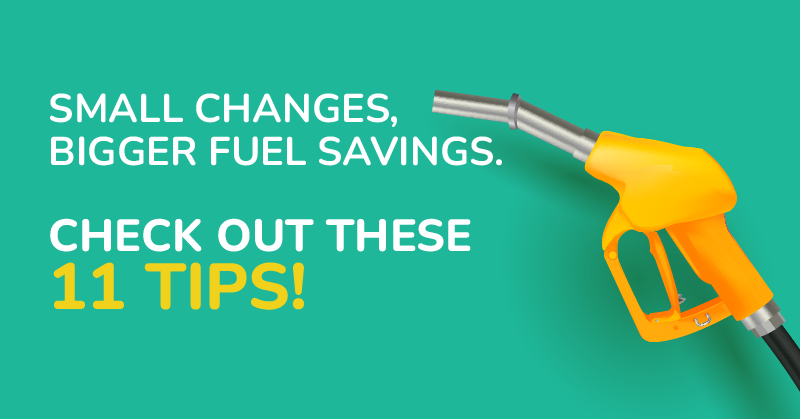
CUT DOWN FUEL CONSUMPTION! USE THESE 11 EASY TIPS.
As the Malay proverb goes, “sikit-sikit lama-lama jadi bukit”. It holds much weight now more than ever as the world is likely to head into a recession come 2023. So, every small change could lead to bigger savings, which could prove useful in the event of financial emergencies.
Now, let’s look at how small driving habits can result in fuel economy. You can be a pro at this, easily! Remember to share with your family and friends, so that they can save more on fuel too.
- Unload the unnecessary.
Sometimes, we unknowingly leave things in the car. The more unnecessary items there are in your car, the more it affects your car’s efficiency. It has been pointed out that every extra 50kg increases fuel consumption by 2%. It may seem like a small change, but less weight inside your car means less work for your car to move forward, resulting in better fuel efficiency. So, the next time you clean your car, do a thorough comb through and remove unneeded items. - Rack on, rack off!
This one is about aerodynamics. The luggage rack on top of your car is great when you’re going on a road trip. But if you aren’t, consider removing them to minimise drag on your car. More drag equals more fuel consumption. Also, keep the windows up especially if you’re cruising above 80km/h. Your engine and wallet will thank you for it! - Air-conditioning situation
This is a tricky one as we’re living in a tropical climate. However, there are days when the temperature is much lower, and that’s when you could consider using less air-conditioning. Turn it on to lower the temperature in the car for a while, and then turn it off while the car remains cool for a period of time. Having the air-cond on all the time adds stress to the motor, and adds fuel usage, especially when you’re moving by inches in traffic.
Also, when you’re visiting the highlands, switch off the air-cond, wind down the windows, and enjoy the cool, fresh air! Don’t worry about drag here, as that usually applies only when you’re driving over 80km/h. - Traffic? Try to avoid it!
Being stuck in traffic contributes to fuel consumption. Regular engagement of your car’s clutches, brakes and accelerator is tiring and annoying, AND it also tires your car’s engine. Over time, it also results in increased fuel consumption. Yes, there’ll be times when traffic is simply unavoidable, but a little research before drive-time could help.
For example, find out which routes take less time and/or are not in a traffic snarl. You could refer to navigation e-maps or apps such as Google Maps or Waze for this. If you’re not already using them, it’s a good time to start!
Alternatively, plan your commute to and from work to avoid the worst of peak traffic. - Inflate tyres to the correct pressure
Every type of tyre has its specific recommended tyre pressure for optimum performance. You can check with the car’s manual, manufacturer or a mechanic. Then, inflate your tyres at the air pump stations the next time you refuel your car. Or drop by your regular car workshop for that.
The right tyre pressure helps improve fuel efficiency. If you’re driving with underinflated tyres, your car’s engine must work harder to move the car forward. - Lower the gear
Instead of applying the brakes before you stop, you could opt to lower your car’s speed from a reasonable distance by lowering the gears. This is also known as “engine braking”. While it doesn’t stop your car completely, it does bring your car to a point where the brakes are used more effectively (less wear and tear) and of course, save on fuel.
- Maintenance, maintenance, maintenance
Can’t run from this one. Almost everything in our life needs maintenance, every now and then. Your car is no different. Servicing your car regularly is good for both your engine and fuel efficiency.
Drop by your regular workshop when it’s time. Check against the manual provided, or the reminder window stickers which suggest a visit to the workshop once you hit a certain mileage. Your car will run more smoothly when all parts of your engine work as it’s meant to.
- The right gear
The different gear options are there for a reason. So, using the right gear helps towards better fuel consumption performance. For example, if you’re travelling at a high speed with a lower gear, it increases load on the engine and shortens the gear’s lifespan. This also directly affects fuel consumption. A simple remedy is to shift the gear up!
- Say no to idling
Idling is when you’re in the car, and not pressing on any of the pedals. For instance, you could be sitting in your car while parked. The car’s engine is still running and your car is idle. While the fuel consumption isn’t as high as when you’re driving, it still uses fuel. Idling for 30 seconds or less is okay. But if you’re parked for a few minutes, switch off the engine.
- Gentle with the pedals
Acceleration requires fuel. The more you accelerate or rev the accelerator, the more fuel goes into the engine. Simple, right? So, watch your speed and avoid aggressive driving, such as rapid acceleration and slamming on the brakes. The more you brake, the more often you’ll need to accelerate again. Plus, tailgating is dangerous and should be avoided.
If you’re driving a manual car, don’t always have your feet on the clutch. This keeps the clutch engaged with the vehicle’s transmission and wears the clutch plates quicker.
- Practice predictive driving
Look ahead to plan your next move. Ease off the accelerator early, if the traffic lights are red. Avoid slamming on the brakes to an abrupt stop. After all, why hurry just to wait?
If you’re reaching the foot of a hill, start gradual acceleration as you are close to it rather than when you’ve reached it. Avoiding hard accelerations is key here.
